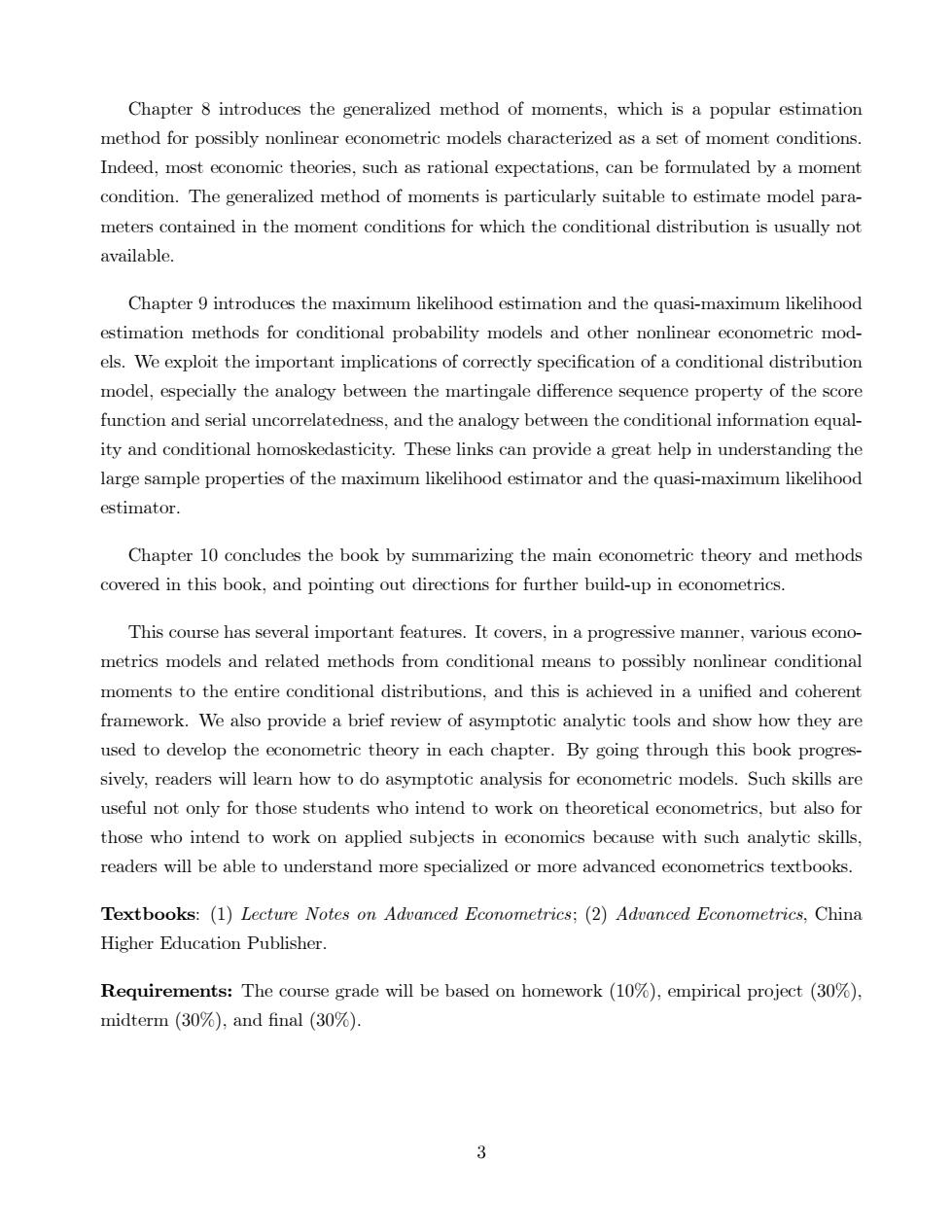正在加载图片...

Chapter 8 introduces the generalized method of moments,which is a popular estimation method for possibly nonlinear econometric models characterized as a set of moment conditions. Indeed,most economic theories,such as rational expectations,can be formulated by a moment condition.The generalized method of moments is particularly suitable to estimate model para- meters contained in the moment conditions for which the conditional distribution is usually not available. Chapter 9 introduces the maximum likelihood estimation and the quasi-maximum likelihood estimation methods for conditional probability models and other nonlinear econometric mod- els.We exploit the important implications of correctly specification of a conditional distribution model,especially the analogy between the martingale difference sequence property of the score function and serial uncorrelatedness,and the analogy between the conditional information equal- ity and conditional homoskedasticity.These links can provide a great help in understanding the large sample properties of the maximum likelihood estimator and the quasi-maximum likelihood estimator. Chapter 10 concludes the book by summarizing the main econometric theory and methods covered in this book,and pointing out directions for further build-up in econometrics. This course has several important features.It covers,in a progressive manner,various econo- metrics models and related methods from conditional means to possibly nonlinear conditional moments to the entire conditional distributions,and this is achieved in a unified and coherent framework.We also provide a brief review of asymptotic analytic tools and show how they are used to develop the econometric theory in each chapter.By going through this book progres- sively,readers will learn how to do asymptotic analysis for econometric models.Such skills are useful not only for those students who intend to work on theoretical econometrics,but also for those who intend to work on applied subjects in economics because with such analytic skills, readers will be able to understand more specialized or more advanced econometrics textbooks. Textbooks:(1)Lecture Notes on Advanced Econometrics;(2)Advanced Econometrics,China Higher Education Publisher. Requirements:The course grade will be based on homework (10%),empirical project (30%), midterm (30%),and final (30%). 3Chapter 8 introduces the generalized method of moments, which is a popular estimation method for possibly nonlinear econometric models characterized as a set of moment conditions. Indeed, most economic theories, such as rational expectations, can be formulated by a moment condition. The generalized method of moments is particularly suitable to estimate model parameters contained in the moment conditions for which the conditional distribution is usually not available. Chapter 9 introduces the maximum likelihood estimation and the quasi-maximum likelihood estimation methods for conditional probability models and other nonlinear econometric models. We exploit the important implications of correctly speciÖcation of a conditional distribution model, especially the analogy between the martingale di§erence sequence property of the score function and serial uncorrelatedness, and the analogy between the conditional information equality and conditional homoskedasticity. These links can provide a great help in understanding the large sample properties of the maximum likelihood estimator and the quasi-maximum likelihood estimator. Chapter 10 concludes the book by summarizing the main econometric theory and methods covered in this book, and pointing out directions for further build-up in econometrics. This course has several important features. It covers, in a progressive manner, various econometrics models and related methods from conditional means to possibly nonlinear conditional moments to the entire conditional distributions, and this is achieved in a uniÖed and coherent framework. We also provide a brief review of asymptotic analytic tools and show how they are used to develop the econometric theory in each chapter. By going through this book progressively, readers will learn how to do asymptotic analysis for econometric models. Such skills are useful not only for those students who intend to work on theoretical econometrics, but also for those who intend to work on applied subjects in economics because with such analytic skills, readers will be able to understand more specialized or more advanced econometrics textbooks. Textbooks: (1) Lecture Notes on Advanced Econometrics; (2) Advanced Econometrics, China Higher Education Publisher. Requirements: The course grade will be based on homework (10%), empirical project (30%), midterm (30%), and Önal (30%). 3